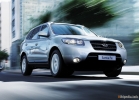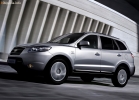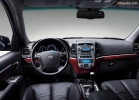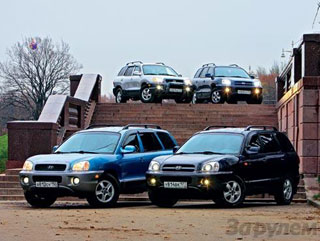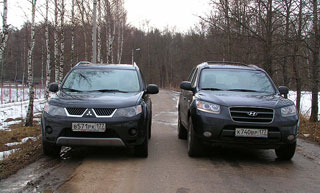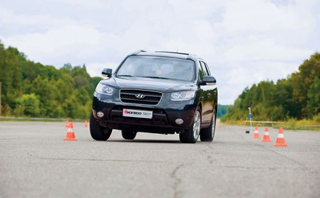Hyundai Santa Fe 2006 test drive - 2009 SUV
Diesel and "automatic"
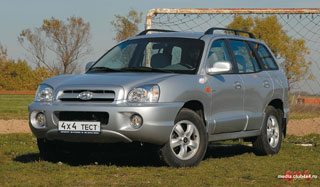 Diesel and machine gun a tempting combination. This is the version of Hyundai Santa Fe Classic that we took for a test. And at the same time, the impressions of this new old model refreshed. Everyone who opens their choice on the old Hyundai Santa Fe, said about the same thing ...
Diesel and machine gun a tempting combination. This is the version of Hyundai Santa Fe Classic that we took for a test. And at the same time, the impressions of this new old model refreshed. Everyone who opens their choice on the old Hyundai Santa Fe, said about the same thing ... Well, yes, it doesn’t look cool, but what else can I buy new and all -wheel drive not more than $ 30,000? It sounds plaintively, but the way it is.
I will not say for all of Odessa, but ..
Do you know how old is this model? Eight! It was first shown in 1999 in Detroit. The company Hyundai was then just starting the capture of the North American market. Hence the choice of place for the debut, and the California name. Well, this year, the good old Santa Fe received Russian citizenship and the Classic prefix so as not to be confused with the new generation. It is now being produced at the Taganrog Automobile Plant.
The car is not just assembled on the shores of Azov there is also welded and stained its body. I will not tell you for all of Odessa, but the copy we have taken for a test is made very decently. The gaps between the body panels are even, the doors are closed, open clearly, the color is even in a word, nothing gives a domestic manufacturer.
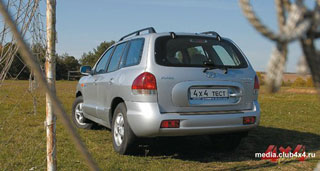 With careful study, a number of pleasant nuances are found. Firstly, pens, including on the fifth door, are made under a natural grip. By the way, the trunk handle is getting dirty not much. Secondly, the front bumper is mowed from below, which increases the angle of entry. Thirdly, a platform for getting up on the rear bumper. Fourth, and there are towing loops in front and behind (now you will not meet them on every SUV, not to mention crossovers). Why am I focusing on these details? And to the fact that they are model. This is not a dream car, but a car for real life.
With careful study, a number of pleasant nuances are found. Firstly, pens, including on the fifth door, are made under a natural grip. By the way, the trunk handle is getting dirty not much. Secondly, the front bumper is mowed from below, which increases the angle of entry. Thirdly, a platform for getting up on the rear bumper. Fourth, and there are towing loops in front and behind (now you will not meet them on every SUV, not to mention crossovers). Why am I focusing on these details? And to the fact that they are model. This is not a dream car, but a car for real life. How bad are you?
The Koreans cost more boldly with the salon than with the body. If the bivalve frame of the central console does not cause you any associations, then you are simply not spoiled enough. And if without jokes, then inside the car does not at all make the impressions of the obsolete. The salon is generally not bad and pulls on a hard four with a plus. However, in order to understand why not five, you will need some capacity. For example, the nests under the upper row buttons on the central console are slightly different in size. Not criminal. But anyway. True, the vast majority of consumers will most likely not pay attention to this, but to unexpectedly high -quality finishing materials. Soft plastics, the skin of the seats, the upholstery of the doors is all without a claim for luxury, but very, very solid.
As for the driver’s landing, for me with a height of 186 cm, it is slightly high. Even with the most lowered seat. There is enough air above the head, but in general, it would be more comfortable a little lower. And with longitudinal adjustment of the chair the same story. A little back to move, and it would be great. Or maybe there is no steering column is regulated only by inclination. As a result, landing on four.
The rear passengers were lucky. The sofa is comfortable, there are many legs for legs, cup holders and pockets on the backs of the front seats have something else to need for happiness? Unless the changeable tilt of the back, so it is present.
As for the trunk, it has rigging loops, a mesh for attaching cargo and numerous containers under the false floor for a rag, tool and other things. It is a pity that the folded rear seats are not formed.
Matter: Hyundai Santa Fe Classic
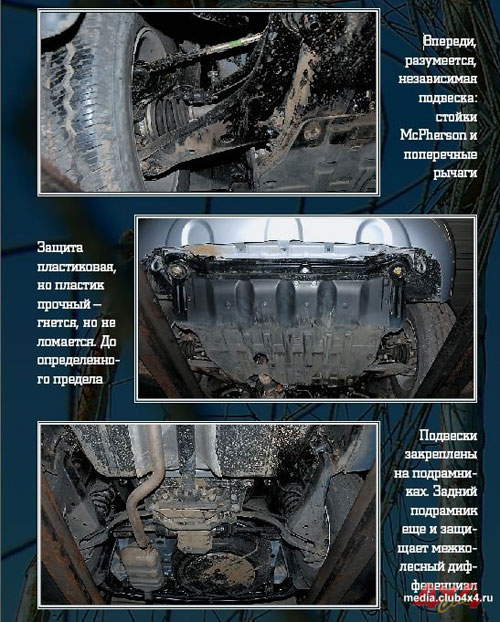
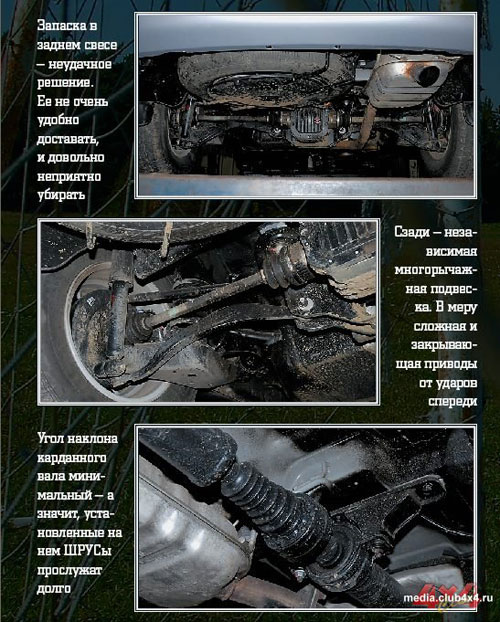
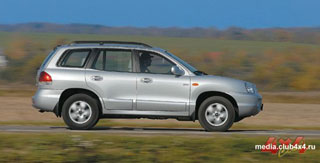 No need to rush
No need to rush In terms of controllability, Santa Fe Classic is a middle peasant. Neither enthusiasm nor complaints of the steering wheel and feedback, the effectiveness and sensitivity of the brakes are caused. The rolls are big in corners, when compared with modern crossovers. However, the new Santa Fe in smooth turns leans less, but with sharp maneuvering it floods on board stronger. But the Classic trajectory keeps dignity even on a bad road both on the arc and on the straight line.
By the way, with the smoothness of the course, everything is classically: a kind of compromise option. You feel the little things, large irregularities, too, but without much discomfort. The energy intensity of the suspension is enough to prevent breakdowns.
Regarding the configuration of the AT3 diesel, I heard many nasty things from colleagues who skated on it at a presentation in Taganrog. Say, he doesn’t go at all. And why would it ride, the engine is just 2.0 liters, albeit with direct injection and turbine. In fact, acceleration to hundreds is long, but to the 60 km/h necessary in the city, it is quite fast. The failure at low speeds of turboyama is felt, and the turbine works somewhere at 2500 revolutions. True, the transmission is configured so that it is convenient to hold the tachometer arrow in the working range from 2 to 3 thousand revolutions. This can be done in automatic mode and in the manual box there is an imitation of sequential switching. However, manual switching only at first seems the best option for acceleration. It is worth getting an end, and you understand that the machine is very sensitive to the intensity of pressure on the gas pedal and it may well, for example, keep a third gear of kilometers up to 95 per hour.
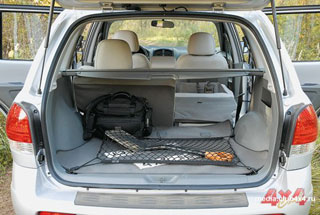 With urban movement, diesel Santa does not create any problems at all. The engine allows, if necessary, to leave the traffic light first (unless, of course, around a small -leaf, and not Porsche Cayenne and BMW X5), and overtaking at speeds up to 100 km/h, can easily. That's when you go faster here, yes, you need a stock. But in general, the dynamics is acceptable. In the end, the diesel engine is not chosen for the sake of rapid overtaking, but for the sake of saving or traction on the bottoms. But in this case, of course, only the first is true. According to our measurements, in the city the consumption is kept within 11.2 liters per 100 km (the on -board computer shows a little more than 11.7). Well, on the track it all depends on the temperament of the driver. If you cynically violate the speed mode, the benefit of 140 km/h the car is without much stress, then the consumption will be no less, or even more urban. If you go 100110, then liters 8 per hundred will come out.
With urban movement, diesel Santa does not create any problems at all. The engine allows, if necessary, to leave the traffic light first (unless, of course, around a small -leaf, and not Porsche Cayenne and BMW X5), and overtaking at speeds up to 100 km/h, can easily. That's when you go faster here, yes, you need a stock. But in general, the dynamics is acceptable. In the end, the diesel engine is not chosen for the sake of rapid overtaking, but for the sake of saving or traction on the bottoms. But in this case, of course, only the first is true. According to our measurements, in the city the consumption is kept within 11.2 liters per 100 km (the on -board computer shows a little more than 11.7). Well, on the track it all depends on the temperament of the driver. If you cynically violate the speed mode, the benefit of 140 km/h the car is without much stress, then the consumption will be no less, or even more urban. If you go 100110, then liters 8 per hundred will come out. Maybe, although it should not
It is clear that Santa Fe Classic was not created for off -road. In normal mode, his front drive and reaction are characteristic. It is impossible to enable the 4x4 mode. If necessary, the rear wheels are connected automatically, through the WISK MAWTU. On the one hand, a minimum of electronics, on the other, a slight inconsistency between the emergence of a critical situation and reactions to it. You will try to stupidly put pressure on the gas on the loose soil and the front wheels will dig up before the rear enters the game and will be able to help them. This good old Santa will not give you cheat sheets in the form of fashionable anti -industrial systems. If you have not learned the rhyme, do not skid, do not skid, and not ..., do not wait for gifts.
Having experienced a crossover on a lane broken by trucks, I can report the following: first of all, it clings to the soil with a subframe, very successfully located in front of the rear gearbox. This is for sure, because I myself then picked this stuck soil. The distance from the Earth to the subframe (they are at the same level) is 22 cm. The rest of the bottom is flat, neat, as if it were not a crossover, but SUV. Neither a muffler hanging can, nor a carefree sticking gas tank. The rear suspension, although independent multi -link, does not look like a gentle. The front also looks good, thoroughly. Yes, and even at low speed on hard bograms and Classic pits, it goes perfectly, as if floating. All this is not a reason to climb it in a buuse, but it’s still nice.
So what do we get in the dry residue? Santa Fe Classic does not have enough stars from the sky, but it stands tight on the ground. It is not suitable for the rider (even if it is with a gasoline engine), but will give pleasure to an experienced driver who can ride calmly. He has an economical diesel and good automatic transmission. A pleasantly trimmed salon, quite spacious for the transportation of a family. The comfortable place of the driver, provided that you are not very high. And an interesting price of the AT3 configuration (diesel-App-Kozha-Climate Control) 769 900 rubles ($ 30 800).
Two questions remain behind the brackets: how diesel Santa will make friends with Santa Claus and what happens to him in a quick turn on a slippery road when all -wheel drive automatically connects. We will certainly get answers to them, because Santa Fe Classic will remain in the editorial office on a long test until spring.
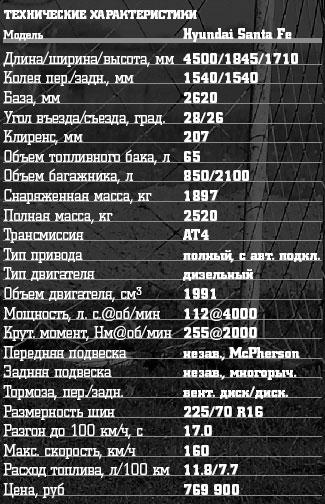
Author: Savva Safonov, photo of Alexander Ortnova-Baranova
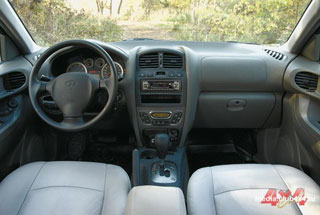
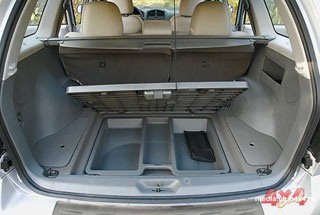
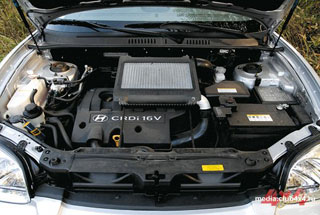
Source: Magazine 4x4 [December/2007]
Hyundai Santa Fe 2006 Krash Video - 2009
Hyundai Santa Fe 2006 test drives - 2009
Hyundai Santa Fe 2006 Krash Test - 2009
Krassh Test: Detailed Information29%
Driver and passengers
36%
Children-passengers


